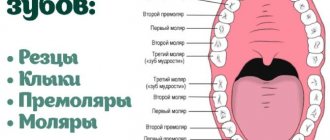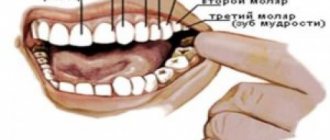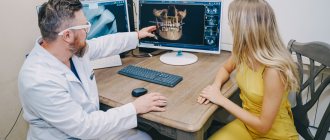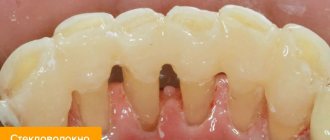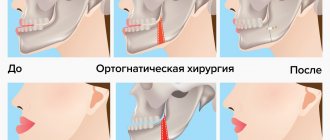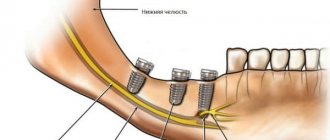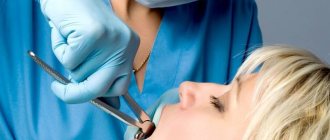- what a panoramic photograph of teeth shows,
- pros and cons in comparison with CT and targeted images,
- orthopantomogram price for 2021.
An orthopantomogram is a traditional type of x-ray examination in dentistry and maxillofacial surgery, which allows you to obtain a detailed image of the upper and lower jaws (along with teeth) in 1 image. These images are also called panoramic X-rays. This name stuck because such a picture shows a detailed picture of the state of the entire dental system “from ear to ear,” which is very convenient for dentists.
Thus, a panoramic photograph of the teeth allows the dentist to see the condition of all teeth at once, which was previously possible only with the help of a large number of targeted photographs. In addition, in this type of images the maxillary sinuses, as well as the temporomandibular joints, are more or less clearly visible. Panoramic radiography is an inexpensive and convenient diagnostic tool because allows you to see all problems at once. However, the diagnostic capabilities of panoramic images are still limited, especially in comparison with CT images.
Panoramic radiography in dentistry: photo
When is a jaw x-ray taken?
Tell the patient exactly whether he needs and can have x-rays of his jaws
, should his attending physician. General indications for such a diagnostic procedure are:
- Suspicion of jaw development abnormalities (in childhood or adulthood). These may be congenital clefts of the hard/soft palate, impaired growth and proper development, or malocclusion.
- Suspicion of infectious-inflammatory and specific pathologies. These include osteomyelitis, periostitis, syphilis, actinomycosis, tuberculosis or necrosis of the jaw bone.
- To identify various acquired defects resulting from injury or removal of oncological formations.
- Suspicion of the presence of a false joint.
- Suspicion of a benign or malignant neoplasm.
What can you see in the photographs?
The following can be seen on x-rays of the upper and lower jaws:
- defects - cracks, fractures, presence or absence of bone fragments;
- pathological changes in bone tissue - areas of tissue thinning, compaction, thickening or thinning of the cortical plate;
- areas of necrosis - sequestra;
- sclerotic process;
- various periosteal layers, osteophytes (bone growths);
- tumor-like neoplasms.
Basic safety measures during
X-rays must be carried out behind closed doors in a separate room. Before the procedure, the child must be wearing a protective lead apron, which will separate the examination area from the rest of the child’s body. At the time of X-ray diagnostics, parents have the right to be close to their child in order to fully control the situation.
It is recommended to use a digital X-ray sensor instead of classic film, which can significantly reduce the radiation dose to the child.
How is the procedure performed?
X-ray of the jaw of an adult or child is a simple procedure. It can be done in different projections in order to better examine the structure of the bone tissue and make an accurate diagnosis.
X-ray of the lower jaw
To obtain general information about the condition of the lower jaw, an X-ray is taken in a direct projection. It allows for primary diagnosis of inflammatory, oncological and traumatic diseases. The patient is positioned as follows: lying on his stomach, face down, resting the tip of his nose and forehead on the cassette. The X-ray machine sensor is installed at the occipital protuberance.
A lateral view of the lower jaw is taken to assess the condition of the body, ramus and teeth of the desired side. The patient lies on his side, with his cheek on the cassette located at a slight angle.
To diagnose diseases of the lower jaw, images are also taken in the axial projection. The patient takes a position lying on his stomach, stretching his head forward with his chin as much as possible. At the same time, it is pressed against the cassette by the front surface of the neck and lower jaw.
X-ray of the upper jaw
To assess the condition of the bone tissue of the upper jaw and the chin area of the lower jaw, a nasomental placement is performed. To do this, the patient lies on his stomach, face down, resting the tip of his nose and chin on the cassette. The sensor is installed perpendicular to the cassette, 2 pictures are taken - with the mouth open and closed.
Orthopantomogram or CT – which is better?
In principle, it is pointless to compare them, because... An orthopantomogram has hundreds of times less diagnostic value compared to dental computed tomography (CT). An orthopantomogram provides a two-dimensional flat image in only one slice, while a CT scan provides a three-dimensional 3D image of the area under study, which can be studied in different slices and planes on a personal computer screen.
In addition, a CT image distorts the size of objects in the image from their real values, provides amazing clarity of bone and tooth structures, and the image itself has much higher resolution and image clarity. CT allows you to examine either a group of several teeth or the entire dental-facial system (that is, you will receive exactly the same panoramic image of the teeth, only three-dimensional).
Moreover, it is these three-dimensional 3D images that are best taken before dental implantation - to assess bone tissue, and these images also allow you to simulate the position of future implants. CT is indispensable for searching for cracks and root perforations in the treatment of complex curved root canals. Only CT will allow you to accurately diagnose all your dental problems and reduce the risk of medical errors in diagnosis. We hope that our article on the topic: Orthopantomogram (panoramic image of teeth) was useful to you!
Sources:
1. Higher prof. the author’s education in therapeutic and surgical dentistry, 2. Based on personal experience in therapeutic and surgical dentistry, 3. National Library of Medicine (USA), 4. “Digital and film radiography in outpatient dentistry” (Chibisova), 5. “X-ray diagnostics in dentistry" (Lutskaya I.K.).
Panoramic shot of the jaw
A panoramic X-ray, or orthopantomogram, displays the entire upper and lower jaw in a direct projection. In such a picture you can see almost all the anatomical features of the patient’s dental system, all kinds of neoplasms, defects, fractures of tooth roots, and so on. An orthopantomogram allows you to identify the following pathologies:
- damage to tooth roots by caries;
- hidden carious cavities;
- cysts, granulomas, tumors;
- pathological changes in the roots and peri-root space.
Main indications for x-rays in childhood
Children need dental x-rays much more often than many adults. This is explained by the fact that baby teeth are most susceptible to the formation of caries, which develops mainly in places that are difficult to access for instrumental examination. In addition, diagnosis using x-rays is necessary in order to identify problems that may arise during the eruption of molars. Therefore, X-ray examination is necessary to carry out the most correct orthodontic treatment.
Decoding the results
An x-ray of an adult's jaw is usually interpreted by a radiologist.
Other specialists may also be involved in this work: dentist, facial surgeon, otolaryngologist. Specific pathologies of the upper and lower jaws have certain radiological features:
- Chronic osteomyelitis. Depending on the type of disease, the images may show foci of resorption of various shapes with a shadow of necrotic masses inside. In more severe cases, communication of the sequestra with the oral cavity is visualized.
- Acute osteomyelitis. When examining the image, you can see areas of bone tissue resorption that do not have clear boundaries.
- Fractures or cracks in the jaw bones. This pathology reveals itself by the fact that thin, elongated shadows are quite clearly visible in the photographs. In such cases, it is important not only to identify the fracture, but also to see the bone fragments, if any, and to understand how much they are displaced.
- Chronic periostitis. In the image with such a pathology, periosteal thickenings will be visible. If the disease has become severe, areas of ossification of the periosteum and new bone tissue along the edge of the jaw are visualized.
Orthopantomogram: price in Moscow for 2021
The price for a panoramic dental photograph will depend on whether it is digital or film. Digital photographs are taken with more expensive equipment and are of better quality, so film photographs always cost less. Thus, if you want to take a panoramic photograph of your teeth in Moscow inexpensively, then it will be a film photograph...
- film panoramic shot - from 700 to 800 rubles,
- digital panoramic image - the price starts from 1000 rubles (and this price already includes recording the image on a CD). If you need a printout of a digital photograph on film, it will cost an additional 150-200 rubles. Printing a digital photograph on film allows you to achieve excellent detail and clarity of the image, but if such a photograph is printed in other ways, the image quality is lost.
Moreover, in a number of clinics, diagnostic panoramic images are taken for free, but for this you need to be a patient of this clinic. If you want to take an image to send to another clinic, you will have to pay the full cost.
Analysis of a panoramic photograph of teeth –
If you take an image in a professional clinic, the radiologist should always provide a description of the image, which will list the problems identified. But in our country, such an attitude to work is not common, and usually the dentist analyzes the image already at the appointment. If you want to try to independently determine something on an x-ray, then in principle you can try to do this.
For example, it is quite possible to see the position of wisdom teeth, determine the quality of root canal filling, see inflammation at the tips of the roots of teeth (granulomas and cysts, Fig. 5), and consider the decrease in the level of bone tissue during periodontitis. To see what the corresponding pathology looks like on X-rays, follow the links above and compare with what you see on your panoramic image.
Analysis of a digital panoramic image –
Is a dental x-ray dangerous when breastfeeding?
X-ray radiation does not accumulate in the environment, but, like light waves, passes through objects, lingering a little longer in a dense environment, a little less in a more rarefied environment. So, all those who are concerned about the question of whether a nursing mother can have a dental x-ray done should answer: “Yes, you can!” Irradiation will not “spoil” milk. It can only linger in the mammary glands themselves. In dentistry in particular and in medicine in general, microdoses of radiation are used, several tens of times less than those recognized as dangerous and causing immediate dire consequences, so dental x-rays during breastfeeding, if there are indications and high-quality devices, are quite safe. For your own peace of mind after the procedure, you can skip one feeding - this will be enough.
Indications
- Diagnosis of jaw injuries (fracture or dislocation)
- Diagnosis of congenital malformations or malocclusions
- Diagnosis of infectious bone lesions such as tuberculosis, syphilis, osteomyelitis or necrosis
- Detection of pseudarthrosis or arthritis of the joint
- Diagnosis of jaw bone tumors (benign and malignant).
- Finding out the causes of swelling and pain in the jaw area
- Periodontitis
- Cystic formations
- Dental pathology, including wisdom teeth
- Sinusitis
X-ray of the jaw in children
Problems with teeth, as well as with the development of bite, begin to bother a person from a very early age. Pediatricians constantly monitor the teething process in very young children. Parents can also seek advice from pediatric dentists if there is a suspicion that something is going wrong.
A procedure such as an x-ray of a child’s jaw is prescribed quite often today. There is no need to be afraid that X-rays can negatively affect the child’s health - the modern equipment used for the study is characterized by minimal radiation exposure. X-ray can be considered a safe diagnostic method.
Features of baby teeth
The structure of baby teeth is similar to permanent teeth: in the jaw there are such types of teeth as incisors, canines, premolars and molars - all like in adults. Only their number differs: for children – 20, for adults – 32.
Baby teeth are formed in the sixth week while still in the womb. After the birth of a child, teeth erupt at about 6 months and grow in by 3-4 years. The exact age depends on the individual's rate of development.
However, there are some differences from permanent teeth:
- baby teeth have long roots that are easily absorbed over time
- greater distance between teeth - so that falling out for replacement is easy
- thinner and more delicate enamel
- softer dentin and surrounding tissues
How safe is an X-ray of a child's jaw?
X-rays of the jaw for children, including infants, are a relatively safe procedure. The radiation exposure during imaging is negligible and cannot negatively affect the further development of the dental system. At the same time, it must be said that taking X-rays without indications, for prevention, is still not worth it.
Contraindications for
Contraindications to X-raying a child’s jaw are:
- unsatisfactory general condition of the child;
- bleeding;
- pathologies in the thyroid gland.
Photo of baby teeth
X-ray of primary teeth is an effective method to identify emerging problems.
through modern diagnostics.
As you know, many children have a hard time going to the dentist. Parents and doctors have to come up with various tricks in order to put the child in a chair and carry out the necessary procedures.
In addition, a pediatric dentist must have certain knowledge in the field of education and psychology, as well as have extensive work experience in order to know what approaches can be applied to a child for successful treatment. Not all clinics have such doctors, and the wrong approach can harm the child’s psyche and initially spoil his attitude towards the doctor’s office.
In order to prevent the need for frequent visits to the dentist, it is necessary to bring your child for preventive examinations.
An X-ray of baby teeth in children will allow you to see:
- condition of tooth roots;
- condition of soft tissues (and gums);
- determine the location of dental root primordia;
- more accurate timing of loss of primary teeth.
Since the process of replacing baby teeth with permanent ones accompanies the child and his parents for several years, it is worth paying special attention to diagnosing the position of the teeth and their quality condition.
Where can I get diagnosed?
The determination of whether a CT scan or dental x-ray is better for a particular patient is made by the attending physician. Before dental treatment, especially before performing prosthetics, implantation and surgical interventions, mandatory hardware diagnostics are required - an orthopantomogram (X-ray) and/or computed tomography (CT). A single registration center for diagnostics was created to facilitate the search for the necessary medical center for examination. On the website mrt-v-spb.ru you can quickly make a choice, taking into account the necessary criteria:
- rating of a medical institution;
- operating mode with the possibility of examination at a convenient time of day;
- Possibility of diagnostics on weekends or holidays;
- class of diagnostic equipment;
- the need to use a contrast agent;
- possibility of examining children.
The service makes it possible to see online availability of available seats for the selected date. Patients independently choose the price limits for diagnostics. The website presents low prices for all types of examinations in the city. Diagnostic centers constantly update discount offers and promotions for testing.
It’s easy to sign up for diagnostics; just call the number provided. Operators will not only sign you up for the study, but will also answer questions and explain for which disease it is better to perform a CT scan or dental x-ray. You just need to provide the name of the medical clinic, a convenient date and time for the examination. Call now and get a discount of up to 1,000 rubles on a CT scan or dental x-ray.
Are there any risks?
Modern X-ray machines are characterized by a low dose of radiation, but since exposure to X-rays cannot be completely ruled out, it is recommended that X-rays be taken no more than 2 times a year for children with baby teeth and no more than once every 1.5 years for adolescents. The need for diagnosis is assessed by the attending physician. If the risk from x-rays is lower than the risk of complications from dental pathology, then the specialist may prescribe a study with a more frequent frequency.
There are no risks of side effects after radiography if all the rules of the procedure are followed. There are no contraindications to the study. The exception is the patient's serious condition or previous irradiation.
For children under the age of one year, an X-ray of the teeth/jaw is taken if other diagnostic methods have turned out to be uninformative or there are contraindications to their use. Thus, children are examined mainly only in case of mechanical injuries.
Is it possible to take dental x-rays during pregnancy?
You should prepare for pregnancy in advance, and your plan for such preparation must include a visit to the dentist. However, if it so happens that it is necessary to take a dental x-ray during pregnancy, you should be guided by specific indications and listen to the doctor’s instructions. It is not recommended to take an x-ray in the first trimester of pregnancy, but it is better to refrain from it until the fifth month. You also need to ensure that the total radiation dose during pregnancy does not exceed 1 mSv. As we have already calculated, this is approximately 300 dental photographs using a modern digital device, or 80 digital orthopantomograms, or 20 computer tomograms. Plus, you should use all possible types of protection: wear a special lead apron on your stomach and collar. It is worth remembering that the stress of going to the doctor and worry about the safety of a particular procedure, not to mention the pain, can cause much more harm to pregnant women than the x-ray itself.

